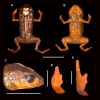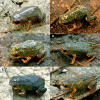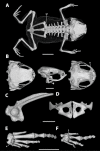A new species of Brachycephalus (Anura: Brachycephalidae) from Santa Catarina, southern Brazil
- PMID: 27812425
- PMCID: PMC5088579
- DOI: 10.7717/peerj.2629
A new species of Brachycephalus (Anura: Brachycephalidae) from Santa Catarina, southern Brazil
Abstract
A new species of Brachycephalus (Anura: Brachycephalidae) is described from the Atlantic Forest of northeastern state of Santa Catarina, southern Brazil. Nine specimens (eight adults and a juvenile) were collected from the leaf litter of montane forests 790-835 m above sea level (a.s.l.). The new species is a member of the pernix group by its bufoniform shape and the absence of dermal co-ossification and is distinguished from all its congeners by a combination of its general coloration (dorsal region of head, dorsum, legs, arms, and flanks light, brownish green to dark, olive green, with darker region in the middle of the dorsum and a white line along the vertebral column in most specimens) and by its smooth dorsum. The geographical distribution of the new species is highly reduced (extent of occurrence estimated as 25.04 ha, or possibly 34.37 ha). In addition, its habitat has experienced some level of degradation, raising concerns about the future conservation of the species. Preliminary density estimates suggest one calling individual every 3-4 m2 at 815-835 m a.s.l. and every 100 m2 at 790 m a.s.l. Together with the recently described B. boticario and B. fuscolineatus, the new species is among the southernmost species of Brachycephalus known to date.
Keywords: Abundance; Atlantic Rainforest; Conservation; Microcomputed tomography; Microendemism; Montane forest; Serra do Mar.
Conflict of interest statement
Marcio R. Pie is an Academic Editor for PeerJ.
Figures








References
-
- Alves ACR, Ribeiro LF, Haddad CFB, Reis SFD. Two new species of Brachycephalus (Anura: Brachycephalidae) from the Atlantic Forest in Paraná State, southern Brazil. Herpetologica. 2006;62:221–233. doi: 10.1655/05-41.1. - DOI
-
- Alves AC, Sawaya RJ, Reis SFD, Haddad CF. New species of Brachycephalus (Anura: Brachycephalidae) from the Atlantic rain forest in São Paulo state, southeastern Brazil. Journal of Herpetology. 2009;43:212–219. doi: 10.1670/0022-1511-43.2.212. - DOI
-
- Bornschein MR, Firkowski CR, Baldo D, Ribeiro LF, Belmonte-Lopes R, Corrêa L, Morato SAA, Pie MR. Three new species of phytotelm-breeding Melanophryniscus from the Atlantic Rainforest of southern Brazil (Anura: Bufonidae) PLoS ONE. 2015;10:e2629. doi: 10.1371/journal.pone.0142791. - DOI - PMC - PubMed
-
- Bornschein MR, Firkowski CR, Belmonte-Lopes R, Corrêa L, Ribeiro LF, Morato SAA, Antoniazzi-Jr RL, Reinert BL, Meyer ALS, Cini FA, Pie MR. Geographic and altitudinal distribution of Brachycephalus Fitzinger (Anura: Brachycephalidae) endemic to the Brazilian Atlantic Rainforest. PeerJ. 2016;4:e2629. doi: 10.7717/peerj.2490. - DOI - PMC - PubMed
LinkOut - more resources
Full Text Sources
Other Literature Sources

